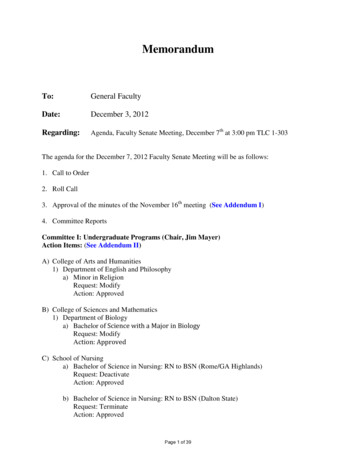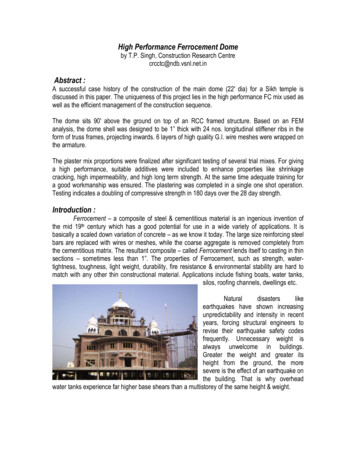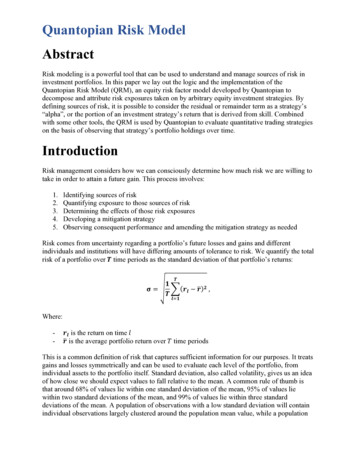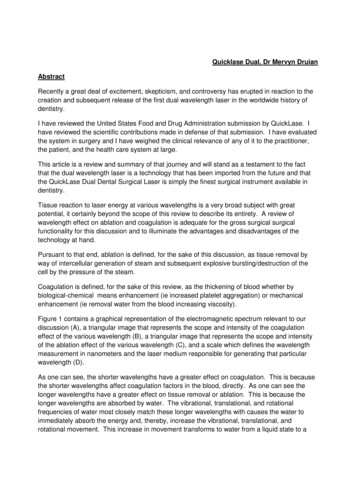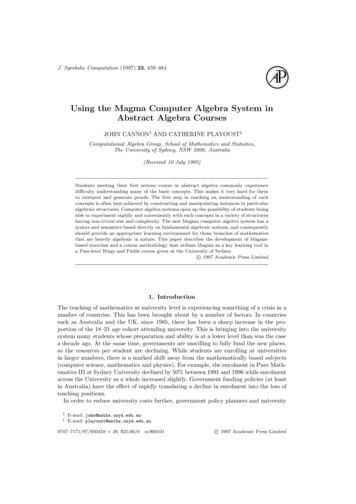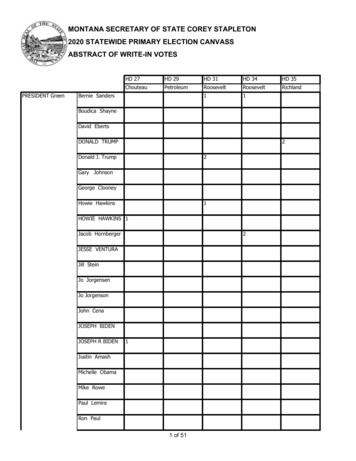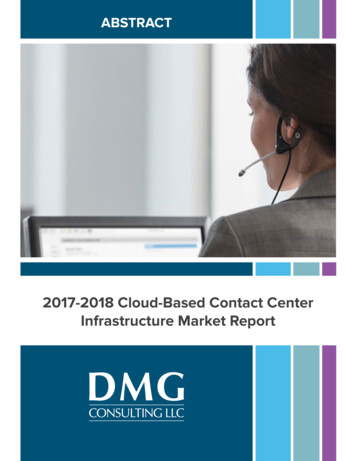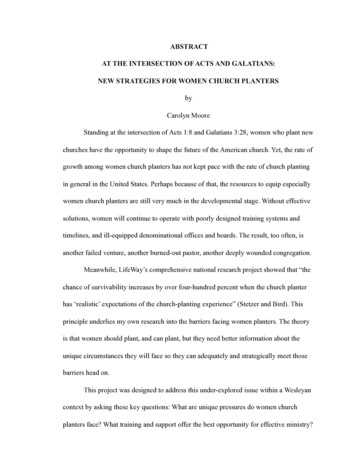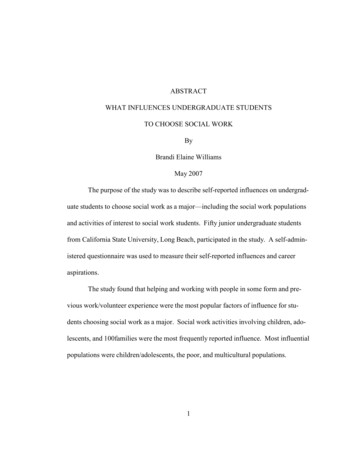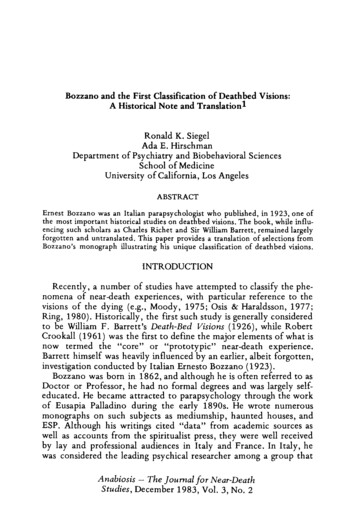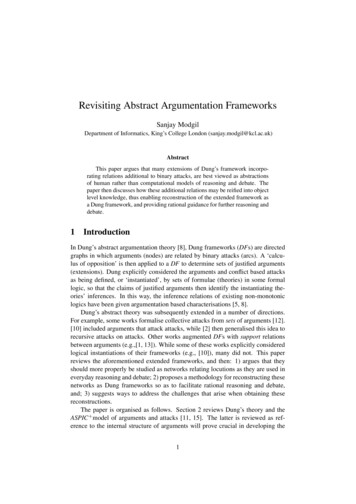
Transcription
Peer ReviewedChristine Andrews is an Assistant Professor at Florida Gulf Coast University. Shecan be reached at candrews@fgcu.edu. Joseph Farinella is an AssociateProfessor at the University of North Carolina at Wilmington. He can be reachedat farinellaj@uncwil.edu. Bradley Hobbs is an Associate Professor at Florida GulfCoast University. He can be reached at bhobbs@fgcu.edu. H. Shelton Weeks isan Associate Professor at Florida Gulf Coast University. He can be reached atsweeks@fgcu.edu.AbstractMore than 11 million students took distance education courses in 1999(Hankin, 1999). Distance learning represents a strategic commitment of manycolleges and universities, which depends in part on the attitudes and perceptions
of faculty towards distance learning. This research describes current practicesand faculty views towards distance learning at the undergraduate and graduatelevels. Information on current offerings using distance technology; the willingnessof faculty to teach using distance delivery modes; the degree to which requisitedistance delivery technologies are used by faculty; and perceived stakeholderdemand for distance education were solicited from members of the accountingprofessorate. Results indicate that one-third of accounting faculty have taughtcourses utilizing distance delivery, and that over two-thirds of accounting facultyare willing to teach courses utilizing distance delivery. In addition, lower levelaccounting courses are perceived as most suitable for distance delivery.
IntroductionDistance education serves the needs of an increasing, non-traditionalstudent population. Distance education can take many forms ranging from theuse of email for communications in lieu of class meetings to the extensive use ofelectronic teaching aids, including live visual transmissions, web boards, andother technologies.Today only 30 percent of college students are considered traditional fulltime college students (Allen, 1997). From 1972-1994, the percentage of collegestudents over 25 increased from 29 percent to 41 percent (Gubernick & Ebeling,1997). Responding to the need created by these changes for flexibility in timeand location of instruction, distance education has become a strategiccommitment of many colleges and universities.Bates (1995) describes distance education as developing in fourgenerations. The first generation (1960s) utilized a traditional delivery modelwhere knowledge was transferred in one direction only, from professor tostudent. The second generation (1970s) utilized more technologies (i.e.audiocassettes, videocassettes), but not the computer. The third generationbegan with the introduction of the personal computer and incorporates moreinteraction, including e-mail, chat rooms, video conferencing, and bulletinboards. The fourth generation builds on the third generation capability, adding toit more synchronous interactions. Most distance education is in the thirdgeneration, but it is expected to move to the fourth generation as bandwidthincreases and software costs decrease. Successful delivery of distanceeducation courses depends, not only upon the competitive use of technology, butalso on solid faculty participation and support.The AACSB Task force on Distance Learning Report (1999)recommended that institutions “ systematically solicit information andperspectives from all involved stakeholder constituencies to provide guidance fordistance learning planning. Such perspectives should be sought regularly toassist planning, implementation, program evaluation, maintenance andimprovement.” The purpose of this study is to assess the current level ofsupport for distance education as well as accounting faculty concerns. Theresults of this study should provide insight for institutions utilizing distancedelivery and for those considering offering programs utilizing distance delivery.
Literature ReviewIn 1998, the National Center for Educational Statistics (Bradburn, 2002)surveyed 960 institutions and 28,704 faculty members . It revealed that about sixpercent of instructional faculty and staff taught distance courses. This survey alsoreported that 90 percent of National Educational Association (NEA) membersstated that distance learning courses were offered or being considered at theirinstitutions. Distance learning courses were distributed similarly across fields.These courses were taught at statewide institutions with multiple campuses (50percent) by full-time faculty (89 percent) who were unlikely to be over the age of55.This study also found that distance learning faculty were more likely to teachat a community college (68 percent). In an AACSB-sponsored study, Britt andFrand (1999) found that 39 percent of the 232 business schools in 11 differentcountries offered distance learning programs. Their data indicate that full-timefaculty are deeply involved in curriculum development and recruitment (84percent) and program supervision and governance (66 percent).In 63 percent ofsurvey responses, full-time faculty taught all distance learning courses. Theadoption of distance learning programs at eminent universities lends addedcredibility to distance learning. Harvard’s online public health program and DukeUniversity’s global MBA broaden the scope of the mission of these institutions aswell as create expectations for economies of scale.Interactive Technologies and Distance EducationAlthough the term distance learning encompasses a wide array ofinstruction methodologies, as previously discussed, the NEA study (2002)reported that virtually all of the faculty teaching distance learning courses use aninteractive technology to teach their courses, with only two percent relyingexclusively on one-way, pre-recorded videos. [1] Of the faculty teaching webbased distance learning courses, 83 percent use email to communicate with theirstudents. Of the faculty not teaching web-based courses, 42 percent use email tocommunicate with their students. Almost all of the respondents (96 percent) haveone-on-one communication with their students either through email, chat rooms,threaded discussion groups, or face-to-face meetings.The 2002 NEA study also found that faculty teaching courses with morestudent interaction were more likely to hold a positive attitude toward distancelearning than faculty with less student interaction. Technical support is alsoconsidered key to successful delivery of educational material. The NEA (2002)reports that 76 percent of distance learning faculty rate technical support as goodor excellent, and 70 percent report that workshops or training sessions areavailable to them on a regular basis. These findings confirm prior research byClark (1993), who found that faculty receptivity, perceptions and attitudes are
relatively complex, and that resource support in the form of both technologiesand development personnel are critical for building faculty support.Faculty Perceptions and AttitudesEarly research on faculty perceptions and attitudes towards participation indistance learning had mixed findings. Studies by Hendrick (1986), Brock (1987),Mulay (1988) and Dillon (1989) concluded that faculty held negative attitudes;while studies by Mani (1988), Dillon (1989), Johnson & Silvernail (1990), andTaylor and White (1991) found that faculty who taught distance learning courseshad significantly more positive attitudes toward distance delivery models. Gilcher& Johnstone (1989), Kirby & Garrison (1989), and Black (1993) found that facultyattitudes become more favorable with experience in teaching distance educationcourses. This finding is confirmed by a follow-up study in 2000 (NEA 2001) thatfound that the majority of distance learning faculty (72 percent) held a positiveopinion of distance learning.In a national survey of business college faculty and administrators, Ross &Klug (1999) addressed factors that influence attitudes of business college facultyand administrators towards distance learning at the baccalaureate and masterslevels of teaching. Their survey utilized a stratified random sample of 1,045 fulltime business faculty and administrators from marketing, management,economics, accounting and finance disciplines. They measured respondents’attitudes towards distance learning and willingness to teach a distance educationcourse. Survey respondents who reported that distance education wasappropriate at their institution and in their specific discipline were more receptiveto and supportive of distance learning. Those respondents with more knowledgeof and/or experience with distance learning reported higher levels of fit than theirinexperienced colleagues.Perceptions of distance learning have also been examined within thebusiness discipline in information systems, economics, marketing, and finance. Ina study of distance learning in information systems departments, 12 of 46respondents planned to use distance learning within the next two years (Morse etal. 1997). Those who did not plan to use distance learning reported that distanceeducation was not viewed as viable because of lack of funding, equipment,administrative support, and faculty support. Most instructors in this study whoutilized distance technologies used web based instruction and interactivetelevision. Farinella et al. (2000, 2003) surveyed finance and economics facultys’current distance learning offerings, willingness to teach, perceptions of suitabilityby specific course area, and current usage of the requisite technologies. In bothstudies, while faculty indicated that their institutions had adequate resources tooffer distance education, they also reported a perceived degradation of qualitywith the implementation of distance delivery. Previous experience teaching adistance course had a significant positive effect on perceived suitability ofcourses and on faculty willingness to teach. Although the existing literature
suggests that distance delivery courses do not compromise overall quality,surveyed finance faculty do not believe that their institutions can utilize distancedelivery without compromising the overall quality of the course. Interestingly, themajority of finance faculty (67 percent) and economics faculty (54 percent) statedthat they are willing to teach using distance delivery. Similar results werereported in a survey of marketing faculty (Langford et al. 2001). In summary,research indicates that faculty members are more likely to view distance learningfavorably with increased teaching experience, adequate technical support, andtraining.Research on distance learning in accounting is not well developed. Thisstudy hopes to provide an understanding of accounting faculty members’attitudes towards distance education and of accounting faculty perceptions ofsuitability of accounting courses for distance delivery.
MethodologyAn electronic survey of accounting faculty was conducted in December2002. The addresses were obtained from “Hasselback’s Guide to AccountingFaculty”. The survey was mailed to 5,915 faculty members, with 666 returned asundeliverable. Based on an estimate of faculty turnover and address changes, a10 percent to 15 percent return rate was obtained. We received 704 usableresponses, resulting in a 13.4 percent response rate.The survey instrument used was similar to the instrument used byFarinella et al. (2000, 2003) and Langford et al. (2001). Information collectedfocused on the following:1.2.Demographic information on the respondentsAttitudes towards the suitability of 17 distinct accounting coursesusing distance delivery3.Current usage of technologies employed to support distance learning4.Perceptions of distance delivery models by various stakeholders5.Assessment of the demand for and viability of distance learningprograms by the institution.Summary statistics were calculated for each survey question. These arereported in the next section. Duncan's multiple range test was used to indicatesignificant differences between responses.Summary StatisticsSummary statistics present a profile of faculty respondents; stability ofacademic environment; survey results of perceived suitability of undergraduateand graduate accounting courses for distance delivery; the level of integration ofdistance delivery into the accounting curriculum at their institutions; and facultyperceptions of demand for distance delivery at their institutions. Survey resultsare also reported for questions regarding adequacy of technological support,perceived impact on course quality, and planning for distance delivery offerings.Table One (below), Panel A, provides a profile of faculty respondents.
Table OneRespondent DemographicsPanel ARank of RespondentsLecturerVisiting ProfessorAssistant ProfessorAssociate ProfessorFull ProfessorPercent6.71.028.132.631.3Panel BNumber of Years as a Full Time Faculty Member0-56-1011-1516-20 2018.917.918.814.129.9Panel CDo you teach at a public or private institution?PublicPrivate69.230.8Panel A indicates that 63.9 percent of respondents were senior facultymembers, with 32.6 percent associate professors and 31.3 percent fullprofessors. Very few lecturers or visiting professors responded to the survey (6.7percent and 1.0 percent respectively). Panel B indicates 62.8 percent ofrespondents were full time faculty members with more than 10 years experience.Panel C indicates over two-thirds of the respondents taught at public institutions.The next group of questions (shown below in Table Two.) was designed todetermine the stability of the faculty member’s academic environment; currentlevels of institutional commitment to distance education instruction; andwillingness to teach a course using distance delivery.
Table TwoAccounting CurriculumPanel AHave substantive changes in pedagogy been made inaccounting curriculum over the past three years?YesNoPercent45.754.3Panel BDoes your institution utilize distance delivery within theaccounting curriculum?YesNo46.153.9Panel CHave you ever taught a course using distance delivery inthe past five years?YesNo35.464.6Panel DWould you be willing to teach a course using distancedelivery?YesNo66.333.7The majority of the respondents (54.3 percent) indicated that there hadbeen no substantive changes in pedagogy in the accounting curriculum over thepast three years. The use of distance delivery appears to be well underway, as46.1 percent of respondents reported their institutions utilized distance delivery.Although 64.6 percent of respondents had not taught a course utilizing distancedelivery in the past five years, 66.3 percent of respondents indicated they wouldbe willing to teach a course utilizing distance delivery.A third set of questions shown below in Table Three measured the levelof integration of distance delivery technologies into the accounting curriculum.Faculty were asked whether specific technologies were currently incorporatedinto the accounting curriculum. Usage of ten technologies commonly associatedwith distance delivery were surveyed ordered by intensity of the level ofintegration. Technologies ranged from the use of email to the use of two-wayinteractive video. The technologies include electronic enhancements to coursesthat may or may not serve to substitute for live class sessions (email, electronic
databases, web pages, chat rooms, electronic journals, bulletin/web boards) andtechnologies that fully replace traditional classrooms (internet courses,telecourses, videotaped classroom sessions, and two-way interactive video).Survey results indicate E-mail and web pages are the most widely usedtechnologies. Telecourses, two-way interactive video, and videotaped classroomsessions were the least used technologies.
Table 3Incorporation of Technology [1]Average Strongly Disagree NoAgreeStronglyDuncan'sRank [2] Disagree (Percent) .316.28.1E(F–Value)[4]19.67(.0001)Web CoursesChat eVideo[1] The table contains the percentage of responses in each category. Sample size is 333.[2] The average ranking is the mean response based on the following: 1 strongly disagree, 2 disagree, 3 no opinion, 4 agree, 5 strongly agree.[3] Differences in the groupings from Duncan’s multiple-range test indicate statistically significantdifferences between the means.[4] The F-value is from a one-way ANOVA test of the null hypothesis that the mean response foreach course is equal. The p-value is in parenthesis.CD
The final row of Table Three reports an F-value for the hypothesis test thatthe means for each technology are equal. The statistic indicates the means arenot equal, and that this is statistically significant at the 0.0001 level. Duncan'smultiple range test was used to determine where these differences occur, andthe test indicates significant differences in the mean responses between thegroupings, while no significant differences exist within the groupings.The next series of questions (Shown below in Table Four.) asked whetherfaculty had taught a course using distance delivery within the past five years and,if so, which undergraduate and graduate courses. The survey also asked whichcourses were currently taught using distance delivery.
Table 4Courses Taught using Distance Delivery Format raduate(Percent)5.984.990.710.430.430.28Accounting TheoryCost0.142.710.140.71Advanced TaxationAdvanced AISAuditOther CourseAdvanced rate TaxAISIndividual TaxInternational AccountingAdvanced AuditAdvancedIntermediate IIntermediate II[1] The table contains the percentage of Yes responses for each course. The sample size is 702.The responses for undergraduate courses shown in Table Four rangedfrom a high of 6.55 percent for managerial accounting to a low of 0.00 percent forinternational accounting. Financial and managerial accounting were the mostfrequently taught courses utilizing distance delivery at the undergraduate level,followed by intermediate II (3.13 percent), intermediate I (2.85 percent), and costaccounting (2.71 percent). Responses for graduate courses identified financialand managerial accounting as the most frequently taught courses utilizingdistance delivery (4.99 percent and 5.98 percent, respectively, but indicateddecreased usage of distance delivery for other graduate courses as compared toundergraduate.Responses to courses currently taught utilizing distance delivery indicatedthat financial accounting was most frequently taught using distance delivery atthe undergraduate level, and financial and managerial accounting were mostfrequently taught using distance delivery at the graduate level. (See Table Five
below.) Financial and managerial accounting at the undergraduate and graduatelevels are generally required core business courses for non-accounting businessmajors.
Table 5Courses Currently Taught Using Distance Delivery [1]ManagerialFinancialCorporate TaxAISIndividual TaxInternational AccountingAccounting TheoryCostAdvanced TaxationAdvanced AISAuditOther CourseAdvanced CostAdvanced AuditAdvancedIntermediate IIntermediate .000.711.000.430.000.000.00[1] The table contains the percentage of Yes responses for each course. The sample size is 702.Faculty were then asked which courses they would be willing to teachusing distance delivery. (See Table Six below.)
at farinellaj@uncwil.edu. Bradley Hobbs is an Associate Professor at Florida Gulf Coast University. He can be reached at bhobbs@fgcu.edu. H. Shelton Weeks is an Associate Professor at Florida Gulf Coast University. He can be reached at sweeks@fgcu.edu. Abstract More than 11 million student
